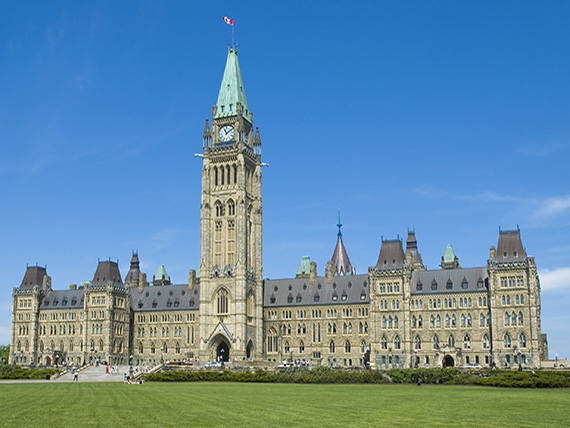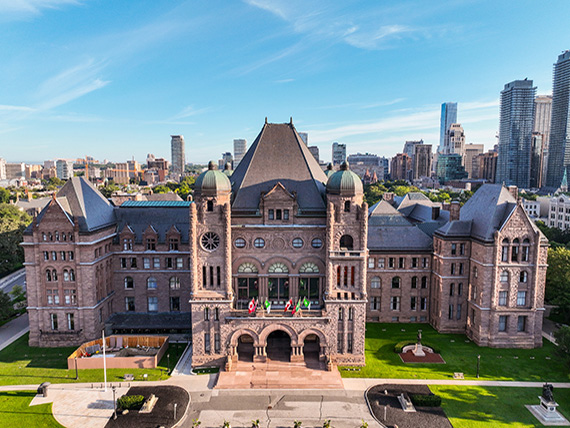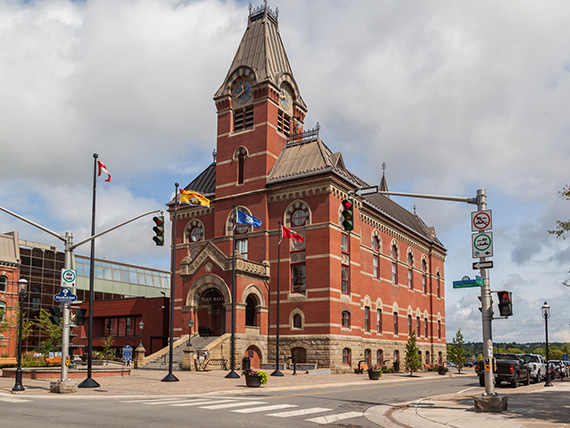How Exactly Do Taxes Matter?
Transferable skills
Curriculum expectations
F. Financial Literacy
F1.6 describe the types of taxes that are collected by the different levels of government in Canada, and explain how tax revenue is used to provide services in the community
A. Political Inquiry
A1.1 formulate different types of questions to guide investigations into issues, events, and/or developments of civic importance
Introduction

Before we can answer our question, let’s first review what taxes are all about.
Taxes are payments that people and businesses pay to the government.
Usually, when someone gets paid from their job, a part of the money they make goes towards taxes. Also, when someone buys something, often a part of their total payment goes toward taxes.
So, taxes go to the government. What are the different types of government in Canada?
Types of government in Canada
The Government of Canada is made up of three levels: federal, provincial/territorial, and municipal. Each level of government is responsible for providing different services to the public.
Before we continue, let’s pause to consider some vocabulary terms connected to our learning.
Vocabulary terms
A tax collected from the income of many individuals and businesses.
A tax collected by the government on many goods and services in Canada and within provinces.
A tax paid by many homeowners or businesses based on the value of land and buildings.
Federal government

Parliament Hill, Ottawa, Ontario.
The federal government is the branch of government that uses collected sales tax and income tax to fund goods and services nationally, or country wide. That means that the federal government oversees all of Canada, which includes legislative authority over First Nations and First Nations reserves.
The federal government’s headquarters is Parliament Hill in Ottawa, Ontario.
Press the Members button to access the members of the federal government.
The members of the federal government include:
- the prime minister
- members of parliament (MPs)
- cabinet ministers
Provincial/territorial government

The Ontario Legislative Building at Queen's Park, Toronto, Ontario
The provincial government is the branch of government that uses collected sales and/or income tax to fund goods and services in each province and territory (e.g., Ontario, Manitoba, New Brunswick, Northwest Territories).
The Ontario provincial government works out of Queen’s Park in Toronto, Ontario.
Press the Members button to access the members of the provincial government.
The members of provincial government include:
- the premier (head of government)
- the executive council (main body)
- members of provincial parliament (MPPs)
Municipal government

Fredericton City Hall building in Fredericton, New Brunswick
The municipal government is the branch of government that uses collected property tax to fund goods and services at the local level. This means that this level of government oversees townships, cities, and municipalities.
The municipal governments work out of their respective city halls.
Press the Members button to access the members of municipal government.
The members of municipal government include:
- the mayor
- city councillors
- school trustees
First Nations, Métis, and Inuit governments
Indigenous communities may have different methods of governing, leadership, and decision-making. Every type of Indigenous government is unique and may have their own tax rules and practices.
Press the following tabs to explore some examples of some First Nations, Métis, and Inuit governments.
One example of national governance is the Inuit Tapiriit Kanatami. The Inuit Tapiriit Kanatami was formed in 1971 by seven Inuit community leaders. It was created due to concern among Inuit leaders about the status of land and resource ownership. Most Inuit live in 51 communities spread across the Inuvialuit Settlement Region (Northwest Territories), Nunavik (Northern Quebec), Nunavut, and Nunatsiavut (Northern Labrador). The Inuit Tapiriit Kanatami represent 70,000 Inuit in Canada.
The Inuit Tapiriit Kanatami is governed by a board that includes:
- a president
- voting members: four directors that represent four regional Inuit land claims organizations
- non-voting members: three non-voting permanent participant representatives
The board communicates Inuit perspective on issues and ensures that Inuit are consulted and accommodated about issues involving treaty rights that could be affected by the Crown (Government of Canada).
Source: Inuit Tapiriit Kanatami. (n.d.). The National Voice for Inuit Communities in the Canadian Arctic. Inuit Tapiriit Kanatami. https://www.itk.ca/national-voice-for-communities-in-the-canadian-arctic/
One example of provincial governance is the Métis Nation of Ontario (MNO). It has existed since 1993 and represents the rights and interests of Métis people. The MNO’s goals include:
- creating a Métis-specific governance structure in the province
- establishing an identification system for Métis people within the province
- focusing on nation building through working together in order to support Métis citizens and communities
- advocating for the Métis existence as a distinct Indigenous people within Ontario
- protecting and preserving the distinct culture and heritage of the Métis Nation in the province
- improving the social and financial well-being of Métis children, families, and communities throughout the province
Source: Métis Nation of Ontario. (2025, March 12). Métis Nation of Ontario | About the MNO. https://www.metisnation.org/about-the-mno/?doing_wp_cron=1744731331.6597130298614501953125 Traditional community-based governance
One example of traditional community-based governance is the Haudenosaunee Confederacy. The Haudenosaunee Confederacy is a League of Six Nations: Seneca, Onondaga, Oneida, Cayuga, Mohawk, and Tuscarora. United by the confederacy, each of the nations are connected by a common goal to live in harmony. Each nation deals with their own affairs but allows the Grand Council to deal with issues affecting the nations within the confederacy. There are 50 Chiefs across the confederacy.
Pause and reflect
Pause and reflect
What were your main takeaways about types of government in Canada?
Create a list of three to five important facts and share with a friend, if possible.
Taxes
Did You Know?
Did You Know?

- Sales tax is a tax added on your purchases in most areas in a province.
- The federal government in Canada charges a federal tax of 5% tax called GST (goods and services tax).
- Most provinces also charge a provincial sales tax (PST).
- Some provinces, like Ontario, have chosen to combine the two taxes (GST and PST) into a single tax called the Harmonized Sales Tax or HST, which includes both the provincial and federal portion.
- In Ontario, your sales receipt will show HST as 13%. The federal government gets 5% and the province gets the other 8%.
Where does the money go?

A conversation with Tiara and Teacher Ravi:
Tiara: Now we know about the types of government and that they collect sales tax, income tax, and property tax. So, where does that money go now?
Teacher Ravi: Great question, Tiara. Let’s figure that out!
Taxes help pay for services and fund different departments who work on solutions for any problems the country, province, or township may face.
Each level of government is responsible for developing different facilities, services, and programs.
Press the following tabs to explore some of the responsibilities of each government. You might notice that there is an overlap of funding between governments for some departments and services.

- National defence
- Education (federally funded schools)
- International affairs
- Money/currency
- Fisheries
- Postal services
- Natural resources
- Railways and pipelines
- Environment
- Criminal law
- Citizenship and immigration
- International trade
- National parks
- Passports
- Employment insurance
- Tourism
- Police
- Responsibilities to First Nations, Métis, and Inuit communities

- Colleges and universities
- Transportation and highways
- Natural resources
- Provincial parks
- Education
- Hospitals and health care
- Marriage
- Tourism
- Police

- Building permits and zoning
- Police
- Fire prevention
- Garbage and recycling
- Water and sewer services
- Municipal roads and sidewalks
- Public transportation
- Municipal parks
- Licensing and control of pets
- Libraries
It’s important to understand how our local government works so that we can all be active members of our respective communities.
Check out the following Explainers video “What is a Local Government?” to learn more about how some local or municipal governments are organized.
As you watch, take note of any new information using a method of your choice.
Self check
Which level of government is responsible for certain services? Place the cards into the categories that best match. Use the arrow buttons to navigate between cards.
Changing your community
Now that you have learned about how government in Canada is organized and where taxes go, it’s time to think about an issue that you would like to see changed. We can all participate in creating change in our communities in different ways.
Check out this video entitled “What is a City Councillor?” to learn more about the things city councillors do for their communities.
You might feel strongly about issues that affect your community. Or you may want to start up a project and feel that the local government should get involved.

Some examples might include:
- compost and recycling programs at your local school
- road maintenance in your neighbourhood (i.e., fixing potholes)
- local park cleanup
Tiara takes action
Tiara has a park in her neighbourhood that she loves to go to with her family. Recently she has noticed a lot more garbage on the ground. She thinks that if there were more signs, and garbage and recycling bins that it might help.

She decides to write a letter to her local city councillor. Tiara feels great taking part in helping her community. Once she is finished her letter, she gets up to stretch before moving on to her next task.
What is an issue you feel strongly about?
Try it!
Try it!
Create your own letter, email, or message about an issue that matters to you.
With permission and support from a trusted adult, search for your local MPP at https://www.ola.org/en/get-involved/contact-mpp and share your thoughts in a method of your choice.